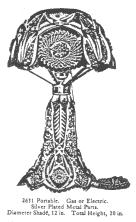Oil, Gas and Electric Lamps
by Mark Nye
Issue 286, February 1997
Webmaster's Note: There are a number of Cambridge catalog pages which accompany this article. They have all been collected and placed on a separate web page. If you wish to view them, click on the link. The page may load slowly on a dial-up connection.
The fledgling Cambridge Glass
Co. was a producer of oil or kerosene lamps. Many, if not all, of these
lamps were made with molds used earlier by other glass companies. In
1899, the Dalzell, Gilmore and Leighton Company of Findlay, Ohio,
became a part of the National Glass Co. At the end of November 1901,
the fires in the furnaces of the old plant were extinguished.
 According
to Measell and Smith in their book "Findlay Glass," National shipped
much of the machinery and fixtures from the old DGL plant to National's
Cambridge plant then under construction. While no mention was made of
mold shipments, undoubtedly this also took place. Since DGL was a large
producer of oil lamps, it is highly likely the oil lamps initially
produced at the Cambridge factory when it opened in 1902 were made
using old DGL molds. Lamp molds from other defunct National Glass
factories may also have been shipped to Cambridge and used. In all
these instances, there is no way to distinguish between
Cambridge-produced lamps and those made elsewhere.
According
to Measell and Smith in their book "Findlay Glass," National shipped
much of the machinery and fixtures from the old DGL plant to National's
Cambridge plant then under construction. While no mention was made of
mold shipments, undoubtedly this also took place. Since DGL was a large
producer of oil lamps, it is highly likely the oil lamps initially
produced at the Cambridge factory when it opened in 1902 were made
using old DGL molds. Lamp molds from other defunct National Glass
factories may also have been shipped to Cambridge and used. In all
these instances, there is no way to distinguish between
Cambridge-produced lamps and those made elsewhere.
By 1906 Cambridge was producing shades for gas and electric lighting fixtures. These fixtures were attached to walls or ceilings and hence were not "portable." Again, molds initially used originated at other companies within the National Glass Co. Examples of such shades are the Nos. 2532 and 2533 shades and the page that does not have a line number in the caption. Later Cambridge made its own lamp shade molds, No. 2626 being an example.
Five years later, in 1911, Cambridge was manufacturing complete gas and electric lamps. Since these could readily be moved from location to location, they were also known as portables. The earliest known trade journal reference for Cambridge gas and electric lamps dates to October 1911 and originally appeared in Crockery and Glass Journal:
"Electoliers in pressed glass are the very latest. The Cambridge Glass Co. has sent to its New York representative two very attractive ones in the 'Near Cut' brand of glass. They are not, of course nearly so costly as cut glass and look mighty good."
In December 1911 the two major trade publications carried a Cambridge advertisement that featured "Fancy Portables and Oil Lamps." The 2760 line is more familiar as Daisy, while No. 31 is from the Marjorie or 2631 line.
For three consecutive weeks in January 1912, China, Glass and Lamps carried a full-page Cambridge advertisement for "NearCut Fancy Portables and Oil Lamps." The lamp featured is from the 2760 or Daisy line.
Gas and electric portables continued to be mentioned in the trade journals during the following years. From a January 1915 article that discussed that year's Pittsburgh show comes this about the Cambridge exhibit: "Gas and electric portables, which are in good demand, add greatly to the display by giving an excellent lighting effect, the arrangement of ware being in good taste and very attractive." After this, lamps received only an occasional mention. This is not surprising since usually it was new items and lines the trade journals commented on and were the featured products in paid advertisements.
Portables, shades for gas and electric lamps, and oil lamp bases were available from a Cambridge catalog issued around 1915-1917. The Cambridge catalog known as Catalog #10 and issued about 1920 contained a page devoted to oil lamp bases but failed to include portables. It is not known if they have been discontinued by this time or were shown in a separate or specialty catalog.
Indications are Cambridge discontinued the production of lamps and shades sometime in the early 1920s.
Also see Night Lamps and Hand Lamps on the supplemental pages.
